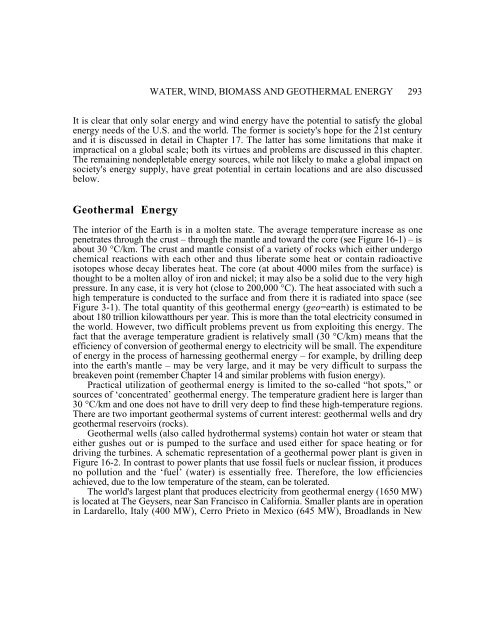Chapter 16 WATER, WIND, BIOMASS AND GEOTHERMAL ENERGY
Chapter 16 WATER, WIND, BIOMASS AND GEOTHERMAL ENERGY
Chapter 16 WATER, WIND, BIOMASS AND GEOTHERMAL ENERGY
Create successful ePaper yourself
Turn your PDF publications into a flip-book with our unique Google optimized e-Paper software.
<strong>WATER</strong>, <strong>WIND</strong>, <strong>BIOMASS</strong> <strong>AND</strong> <strong>GEOTHERMAL</strong> <strong>ENERGY</strong> 293<br />
It is clear that only solar energy and wind energy have the potential to satisfy the global<br />
energy needs of the U.S. and the world. The former is society's hope for the 21st century<br />
and it is discussed in detail in <strong>Chapter</strong> 17. The latter has some limitations that make it<br />
impractical on a global scale; both its virtues and problems are discussed in this chapter.<br />
The remaining nondepletable energy sources, while not likely to make a global impact on<br />
society's energy supply, have great potential in certain locations and are also discussed<br />
below.<br />
Geothermal Energy<br />
The interior of the Earth is in a molten state. The average temperature increase as one<br />
penetrates through the crust – through the mantle and toward the core (see Figure <strong>16</strong>-1) – is<br />
about 30 °C/km. The crust and mantle consist of a variety of rocks which either undergo<br />
chemical reactions with each other and thus liberate some heat or contain radioactive<br />
isotopes whose decay liberates heat. The core (at about 4000 miles from the surface) is<br />
thought to be a molten alloy of iron and nickel; it may also be a solid due to the very high<br />
pressure. In any case, it is very hot (close to 200,000 °C). The heat associated with such a<br />
high temperature is conducted to the surface and from there it is radiated into space (see<br />
Figure 3-1). The total quantity of this geothermal energy (geo=earth) is estimated to be<br />
about 180 trillion kilowatthours per year. This is more than the total electricity consumed in<br />
the world. However, two difficult problems prevent us from exploiting this energy. The<br />
fact that the average temperature gradient is relatively small (30 °C/km) means that the<br />
efficiency of conversion of geothermal energy to electricity will be small. The expenditure<br />
of energy in the process of harnessing geothermal energy – for example, by drilling deep<br />
into the earth's mantle – may be very large, and it may be very difficult to surpass the<br />
breakeven point (remember <strong>Chapter</strong> 14 and similar problems with fusion energy).<br />
Practical utilization of geothermal energy is limited to the so-called “hot spots,” or<br />
sources of ‘concentrated’ geothermal energy. The temperature gradient here is larger than<br />
30 °C/km and one does not have to drill very deep to find these high-temperature regions.<br />
There are two important geothermal systems of current interest: geothermal wells and dry<br />
geothermal reservoirs (rocks).<br />
Geothermal wells (also called hydrothermal systems) contain hot water or steam that<br />
either gushes out or is pumped to the surface and used either for space heating or for<br />
driving the turbines. A schematic representation of a geothermal power plant is given in<br />
Figure <strong>16</strong>-2. In contrast to power plants that use fossil fuels or nuclear fission, it produces<br />
no pollution and the ‘fuel’ (water) is essentially free. Therefore, the low efficiencies<br />
achieved, due to the low temperature of the steam, can be tolerated.<br />
The world's largest plant that produces electricity from geothermal energy (<strong>16</strong>50 MW)<br />
is located at The Geysers, near San Francisco in California. Smaller plants are in operation<br />
in Lardarello, Italy (400 MW), Cerro Prieto in Mexico (645 MW), Broadlands in New
















